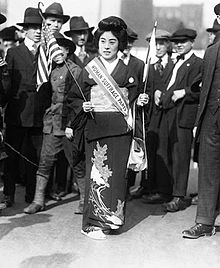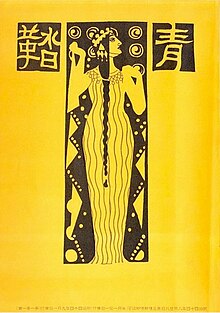Women's movement in Japan
The feminist movement in Japan began in the late 19th century. Groups of different social origins pursued different goals with regard to improving the situation of women in Japan .
One of the significant early successes was the admission to political participation in the early 1920s. Active and passive women's suffrage in Japan was introduced during the occupation in 1945. The movement is seen in part as part of the opening to the west after the Meiji Restoration in 1868 . Others see both western and traditional influences of Japanese culture in the Japanese women's movement. One difference is the somewhat lesser importance of individual autonomy.
history


In the early Meiji period , enlightened intellectuals such as Fukuzawa Yukichi advocated an improved position for women. In the early 1880s, women like Fukuda Hideko (1865–1927) were also active in the movement for civil rights. In 1886 Yajima Kajiko (1833-1925) founded the "Society for Abstinence of Women, Tokyo" (東京 婦人 矯 風 会, Tōkyō fujin kyōfūkai), which from 1893 under the influence of the American pioneer Mary Leavitt (1830-1912) "Christian- Japanese Society for Abstinence for Women ”(日本 キ リ ス ト 教 婦人 矯 風 会, Nihon Kiristokyō fujin kyōfūkai). She not only fought for abstinence, but also for the abolition of prostitution.
Legislation in 1889 and 1890 banned women from political activities, so changing the law was the first target of protests by female socialists and advocates of emancipation. Other women, less concerned with emancipation, turned to public welfare activities. The "Patriotic Women's Association" (愛国 婦人 会, Aikoku Fujinkai) was founded in 1901 by Okumura Ioko (奥 村 五百 子; 1845–1907) with the aim of helping wounded soldiers and relatives. With financial support from the state, the association initially consisted only of upper-class women, but by 1919 it already had a million members, although it was hardly visible locally. - In contrast, the one founded in 1911 by Hiratsuka Raichō (1886–1971), later supported by Yamakawa Kikue (1890–1980), Itō Noe (1995–1923) and Kamichika Ichiko (神 近 市 子; 1888–1881), " Society of Blue Stockings “(青 鞜 社, Seitōsha) on strengthening the self-confidence of women. That was the beginning of a more intellectual activity by the middle class, which dominated the women's rights movement until the 1930s. In 1919, Hiratsuka and Ichikawa Fusae (1893-1981) founded the “New Women's Association” (新 婦人 協会, Shin fujin kyōkai), which was also on this line. With its successor, the "League for Women's Suffrage" (婦人 政 権 リ ー グ, Fujin seiken rīgu), it was particularly about women's suffrage in Japan , but the participation of women workers remained low. After all, a change in the law in 1922 made it possible for women to hold political meetings at all.
After the great Kanto earthquake of 1923 , a number of female aid organizations joined forces to form the Association of Women's Organizations of Tokyo (Tokyo Rengo Fujinkai). Founded with the intention of helping the earthquake victims in the region, the Bund became one of the central contact points and organizational focal point for the Japanese women's movement. The Federation for the Realization of Women's Suffrage (Fujin Sanseiken Kakutoku Kisei Domei), later briefly the Women's Suffrage Federation (Fusen Kakutoku Domei) was founded in this context.
As the first party, the Yūaikai took women from 1916, and in 1921 socialist women founded the "Association of the Red Waves" (赤 瀾 会, Sekirankai). But all of these proletarian groups, though quite combative, remained insignificant since the mass of working women did not participate. So they never reached the size of, for example, that of the Patriotic Women's Association mentioned above, which in 1937 had 3 million members. Opposite her stood at the same level only the "Women's Association for the Defense of Greater Japan" (大 日本 国防 婦人 会, Dainihon kokubō fujinkai), which was founded in 1932 with financial support from the army. Its aim was to strengthen national unity and to create the basis for the mobilization of aid workers. The association had nearly 8 million members in 1938 and was used to control the local mood. Since both organizations competed in the same areas, namely support in the event of a disaster, collection of aid funds, care for the wounded and bereaved, there was increasing friction between the two associations.
In 1942, both associations were merged into the (大 日本 婦人 会, Dainihon fujinkai) within the "Taisei yokusankai" (大 政 翼 賛 会), roughly the "imperially ordered support society". All married women and all unmarried women over the age of 20 were required to be members of society and had to work in production and civil defense. In 1943 the association put the membership at 19 million, but the headquarters' access was never very strong. In June 1945 the company was reorganized again, after the end of the war it was dissolved.
After the war, groups made up of middle class women and Christian groups that had been oppressed before the war emerged. During the time of occupation by the Allies, active voting rights for women aged 20 and over and passive voting rights for women aged 25 and over were introduced on December 17, 1945. In the first post-war election in 1946, 79 women ran for election, 39 of whom were elected. After that, the fight against prostitution was a concern, which was mainly supported by the above. Society for Abstinence for Women was promoted. Groups with more radical goals have also formed, but they have remained small. - Despite the equality according to the law, a certain amount of discrimination persists to the present day.
Representatives and media
Well-known early Japanese feminists include the writer and speaker Kishida Toshiko (1863–1901) and the anarchist Itō Noe (1895–1923). Hiratsuka Raichō (1886–1971) founded in 1919 together with Ichikawa Fusae (1893–1981) the Shin Fujin Kyokai (Association of the New Woman). The poet Yosano Akiko (1878–1942) was one of her fellow campaigners. Katō Shizue (1897-2001) was a member of the Japanese Socialists and one of the first female MPs.
At the beginning of the 20th century, literary magazines such as Seito (“ Bluestock ”), Fujin Koron and Shufu No Tomo played an important role, covering both classically educated middle-class interests and otherwise little-mentioned controversial topics such as abortion and sexuality.
particularities
There are significant gender differences in spoken Japanese . The word onnarashii (女 ら し い), which is usually translated as "womanly" or "feminine", refers to the behavior and style of language that is typically expected of a Japanese woman . Otokorashii (男 ら し い) means to be “male” or “masculine”. Some characteristics of women's language are a high pitched voice, frequent use of politeness and the use of “typically feminine” words. In Japanese, the specific way female speakers use language is also referred to as onna kotoba (女 言葉, “women's words ”) or joseigo (女性 語, “women's language”). In general, the social and hierarchical position of speakers has a significant impact on the structures of language in Japanese.
Japan has the lowest sexual violence crime rate of any industrialized nation. However, train cars are only an issue for women in response to the chikan prevalent in Japan and opposition to other sexist activities.
At the same time, the participation of women in the world of work is significantly lower than in other industrialized countries. The low availability of childcare options is associated with very low birth rates. Japan has the highest life expectancy for both sexes in the world.
See also
- Danson Johi ("Respect for men, disdain for women": principle of the Japanese feudal and samurai period)
literature
- Ilse Lenz , Michiko Mae (ed.): The women's movement in Japan. Springer VS, Wiesbaden 2018, ISBN 978-3-531-14730-7 .
- Michiko Mae (Ed.): Pictures, Reality, Future Drafts: Gender Relations in Japan (= Düsseldorfer Schriftenreihe Gender Research on Japan. Volume 1). East Asia Institute, Heinrich Heine University, Düsseldorf 1996, ISBN 3-9805308-0-9 .
- S. Noma: Women's suffrage. In: Ichirō Katō, Edwin O Reischauer, Kōdansha: Japan: An Illustrated Encyclopedia. Kodansha, Tokyo 1993, ISBN 4-06-205938-X (English).
- Janet Hunter: Women's Movement. In: Concise Dictionary of Modern Japanese History. Kodansha, Tokyo 1984, ISBN 4-7700-1193-8 (English).
- Janet Hunter: Women's Suffrage Movement. In: Concise Dictionary of Modern Japanese History. Kodansha, Tokyo 1984. ISBN 4-7700-1193-8 (English).
Individual evidence
- ↑ Barbara Molony: Women's Rights, Feminism, and Suffrage in Japan, 1870-1925. In: The Pacific Historical Review. Volume 69, No. 4: Woman Suffrage: The View from the Pacific. November 2000, p. 640 (English).
- ^ Sandra Buckley: Broken Silences: Voices of Japanese Feminism. University of California Press, 1997, p. 63.
- ↑ a b c d e Janet Hunter: Women's Movement. In: Concise Dictionary of Modern Japanese History. Kodansha, Tokyo 1984, ISBN 4-7700-1193-8 , pp. ?? (English).
- ↑ a b c Janet Hunter: Women's Suffrage Movement. In: Concise Dictionary of Modern Japanese History. Kodansha, Tokyo 1984. ISBN 4-7700-1193-8 , p. 244 (English).
- ↑ See Milton Diamond, Ayako Uchiyama: Pornography, Rape and Sex Crimes in Japan. In: International Journal of Law and Psychiatry. Volume 22, No. 1, 1999, pp. 1-22 (English; online at hawaii.edu ( Memento of June 2, 2009 in the Internet Archive )).
